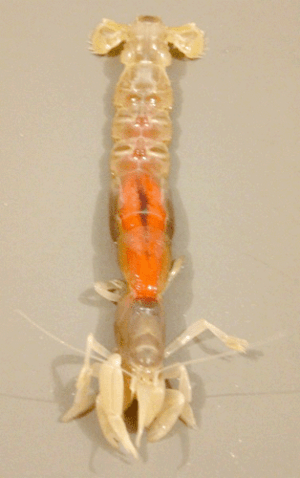Callichirus major facts for kids
Quick facts for kids Callichirus major |
|
|---|---|
 |
|
| Scientific classification | |
| Kingdom: | |
| Phylum: | |
| Subphylum: | |
| Class: | |
| Order: | |
| Family: |
Callianassidae
|
| Genus: |
Callichirus
|
| Species complex: |
C. major s.l.
|
| Binomial name | |
| Callichirus major Say, 1818
|
|
| Species | |
|
C. macrotelsonis, C. major s.s., C. aff. major sp. 1, C. aff. major sp. 2 |
|
| Synonyms | |
|
|
Callichirus major sensu lato (say "sen-soo lah-toh") is a group of ghost shrimp. These shrimp live in sandy beaches along the coasts of North and South America. They are part of a larger group called crustaceans, like crabs and lobsters.
At first, scientists thought Callichirus major was just one type of shrimp. But later, special studies showed it's actually at least four very similar species. They look almost the same, but they are different kinds of animals. One of these is called Callichirus macrotelsonis.
These shrimp have some cool features. Males and females often look different, especially in size. They also have separate sexes, meaning there are male shrimp and female shrimp.
Sadly, these shrimp are often dug up and used as fishing bait. This can harm their populations and the sandy beach environments where they live.
Contents
What is a Ghost Shrimp?
Ghost shrimp are a type of crustacean. They are related to crabs, lobsters, and other shrimp. They get their name because they often live hidden in burrows under the sand. This makes them seem like "ghosts" of the beach!
How Scientists Study Callichirus major
Early Discoveries of Callichirus major
The Callichirus major shrimp was first described in 1818. A scientist named Thomas Say gave it the name Callianassa major. He found it in the Gulf of Mexico and Florida. Later, in 1866, its genus (a scientific group) was changed to Callichirus.
For a long time, scientists grouped these shrimp with other "ghost shrimp" in a group called Thalassinidea. But in 2009, they found that this group wasn't quite right. So, Callichirus major and its relatives were moved to a new group called Axiidea.
Finding New Species in the C. major Group
In 1995, scientists started using genetic testing to study these shrimp. They found that C. major from Colombia was different from those in the United States. This was a big clue!
More tests showed that the C. major group was not just two species, but four!
- One species is the original C. major found in the United States.
- The shrimp from Colombia are a different species.
- Shrimp from Pacific Mexico and Costa Rica are two more distinct species. Scientists call them C. aff. major sp. 1 and C. aff. major sp. 2 for now.
- The shrimp from Brazil were named C. macrotelsonis.
These studies help us understand how different animal groups are related. They also show how animals spread across different parts of the world.
What Callichirus major Looks Like
It's hard to tell the different C. major species apart just by looking at them. They are very similar!
Body Features
- Carapace: This is the hard shell covering the shrimp's head and chest. It has a stiff front edge.
- Rostrum: This is a pointy part at the front of the head. It's usually blunt near the eyes.
- Antennules: These are small feelers near the mouth.
- Legs: The first pair of legs is very different in size, especially in adult males. One leg is much bigger than the other. This is a clear sign of sexual dimorphism (males and females looking different). The second pair of legs has good claws, but the fourth and fifth pairs have weaker claws.
- Abdomen: The first two parts of their tail (abdomen) are soft and thin. The second part is longer than the first.
Separate Sexes
Unlike some other shrimp, C. major has separate sexes. This means there are male shrimp and female shrimp. Each shrimp is either male or female, not both.
Where Callichirus major Lives
C. major lives in open, sandy beaches. They dig deep burrows in the sand. You can find them in the intertidal zone (the area between high and low tide) and in shallow water up to 2-3 meters deep.
They live all along the coasts of North and South America.
- Atlantic Coast: From North Carolina down to Santa Catarina, Brazil. There's a gap where they are rarely found, like from southern Texas to Pará, Brazil, except for a few spots in Colombia and Venezuela.
- Pacific Coast: They have been found in Baja California, Mexico, and Costa Rica.
Why Callichirus major is Important
Used as Fishing Bait
Many people living near the coast use these ghost shrimp as fishing bait. They are easy to find and dig up.
Conservation Concerns
However, digging up too many ghost shrimp can be harmful. It can hurt their populations and the sandy beach ecosystems they live in. Other animals that rely on these shrimp or are accidentally harmed during digging can also suffer.
Some scientists believe that C. major might be critically endangered. This means they are at a very high risk of disappearing forever. However, this status has not yet been officially reviewed by the IUCN, a group that tracks endangered species.

